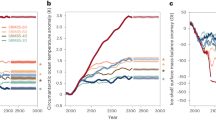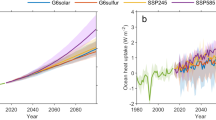Abstract
If implementation of proposals to engineer the climate through solar-radiation management (SRM) ever occurs, it is likely to be contingent on climate sensitivity. However, modelling studies examining the effectiveness of SRM as a strategy to offset anthropogenic climate change have used only the standard parameterizations of atmosphere–ocean general circulation models that yield climate sensitivities close to the Coupled Model Intercomparison Project mean. Here, we use a perturbed-physics ensemble modelling experiment to examine how the response of the climate to SRM implemented in the stratosphere (SRM-S) varies under different greenhouse-gas climate sensitivities. When SRM-S is used to compensate for rising atmospheric concentrations of greenhouse gases, its effectiveness in stabilizing regional climates diminishes with increasing climate sensitivity. However, the potential of SRM-S to slow down unmitigated climate change, even regionally, increases with climate sensitivity. On average, in variants of the model with higher sensitivity, SRM-S reduces regional rates of temperature change by more than 90% and rates of precipitation change by more than 50%.
This is a preview of subscription content, access via your institution
Access options
Subscribe to this journal
Receive 12 print issues and online access
$209.00 per year
only $17.42 per issue
Buy this article
- Purchase on Springer Link
- Instant access to full article PDF
Prices may be subject to local taxes which are calculated during checkout




Similar content being viewed by others
References
The Royal Society Geoengineering the Climate: Science, Governance and Uncertainty (2009); available at: royalsociety.org/WorkArea/DownloadAsset.aspx?id=10768.
Caldeira, K. & Wood, L. Global and Arctic climate engineering: Numerical model studies. Phil. Trans. A 366, 4039–4056 (2008).
Moreno-Cruz, J. B., Ricke, K. L. & Keith, D. W. A simple model to account for regional inequalities in the effectiveness of solar radiation management. Climatic Change http://dx.doi.org/10.1007/s10584-011-0103-z (2011).
Ricke, K. L., Morgan, M. G. & Allen, M. R. Regional climate response to solar radiation management. Nature Geosci. 3, 537–541 (2010).
Jones, A., Haywood, J., Boucher, O., Kravitz, B. & Robock, A. Geoengineering by stratospheric SO2 injection: Results from the Met Office HadGEM2 climate model and comparison with the Goddard Institute for Space Studies ModelE. Atmos. Chem. Phys. Discuss. 10, 7421–7434 (2010).
Roe, G. H. & Baker, M. B. Why is climate sensitivity so unpredictable? Science 318, 629–632 (2007).
Zickfeld, K, Morgan, M. G., Frame, D. J. & Keith, D. W. Expert judgments about transient climate response to alternative future trajectories of radiative forcing. Proc. Natl Acad. Sci. USA 107, 12451–12456 (2010).
Wigley, T. M. L. A combined mitigation/geoengineering approach to climate stabilization. Science 314, 452–454 (2006).
Moreno-Cruz, J. B. & Keith, D. W. Climate policy under uncertainty: A case for geoengineering. Climatic Change (in the press).
Victor, D. G. Global Warming Gridlock Ch. 6 (Cambridge Univ. Press, 2011).
Blackstock, J. J. et al. Climate Engineering Responses to Climate Emergencies (Novim, 2009); archived online at http://arxiv.org/pdf/0907.5140.
Frame, D. J. et al. The climateprediction.net BBC climate change experiment: Design of the coupled model ensemble. Proc. R. Soc. A 367, 855–870 (2009).
Gordon, C. et al. The simulation of SST, sea ice extents and ocean heat transports in a version of the Hadley Centre coupled model without flux adjustments. Clim. Dynam. 16, 147–168 (2000).
Allen, M. R. Do-it-yourself climate prediction. Nature 401, 642–642 (1999).
Murphy, J. M. et al. Quantification of modelling uncertainties in a large ensemble of climate change simulations. Nature 430, 768–772 (2004).
Stainforth, D. A. et al. Uncertainty in predictions of the climate response to rising levels of greenhouse gases. Nature 433, 403–406 (2005).
Nakicenovic, N. & Swant, R. (eds) IPCC Special Report on Emissions Scenarios (Cambridge Univ. Press, 2000).
Sato, M., Hansen, J. E., McCormick, M. P. & Pollack, J. B. Stratospheric aerosol optical depth, 1850–1990. J. Geophys. Res. 98, 22987–22994 (1993).
Allen, M. R. & Ingram, W. J. Constraints on future changes in climate and the hydrologic cycle. Nature 419, 224–232 (2002).
Bala, G., Duffy, P. B. & Taylor, K. E. Impact of geoengineering schemes on the global hydrological cycle. Proc. Natl Acad. Sci. USA 105, 7664–7669 (2008).
Giorgi, F. & Francisco, R. Uncertainties in regional climate change prediction: A regional analysis of ensemble simulations with the HADCM2 coupled AOGCM. Clim. Dynam. 16, 169–182 (2000).
Nordhaus, W. Geography and macroeconomics: New data and new findings. Proc. Natl Acad. Sci. USA 103, 3510–3517 (2006).
Lenton, T. M. et al. Tipping elements in the Earth’s climate system. Proc. Natl Acad. Sci. USA 105, 1786–1793 (2008).
Leemans, R. & Eickhout, B. Another reason for concern: Regional and global impacts on ecosystems for different levels of climate change. Glob. Environ. Change 14, 219–228 (2004).
Visser, M. E. Keeping up with a warming world; assessing the rate of adaptation to climate change. Proc. R. Soc. B 275, 649–659 (2008).
Tilmes, S., Garcia, R. R., Kinnison, D. E., Gettelman, A. & Rasch, P. J. Impact of geoengineered aerosols on the troposphere and stratosphere. J. Geophys. Res. 114, D12305 (2009).
Kirk-Davidoff, D. B., Hintsa, E. J., Anderson, J. G. & Keith, D. W. The effect of climate change on ozone depletion through changes in stratospheric water vapour. Nature 402, 399–401 (1999).
Hoegh-Guldberg, O. et al. Coral reefs under rapid climate change and ocean acidification. Science 318, 1737–1742 (2007).
Solanki, S. K. & Krivova, N. A. Can solar variability explain global warming since 1970? J. Geophys. Res. 108, 1200 (2003).
Cusack, S., Slingo, A., Edwards, J. M. & Wild, M. The radiative impact of a simple aerosol climatology on the Hadley Centre GCM. QJR Meteorol. Soc. 124, 2517–2526 (1998).
Acknowledgements
The authors thank the cpdn participants for their donations of computing power, without which the experiment would not have been possible. We thank M. R. Allen for advice in the design of the experiment, M. I. Thurston and N. R. Massey for deployment of the experiment through the cpdn system and J. B. Moreno-Cruz for comments on the manuscript. K.L.R. acknowledges support from a US National Science Foundation Graduate Research Fellowship. D.J.R. was supported by a Natural Environment Research Council (NERC) PhD studentship with a Collaborative Award in Science and Engineering award from the Centre for Ecology and Hydrology Wallingford. W.J.I. was supported by NERC contract NE/D012287/1 and European Union Framework Programme 6 contract 036946. K.L.R., D.W.K. and M.G.M. acknowledge the support of the Climate Decision Making Center (SES-0345798) and the Center for Climate and Energy Decision Making (SES-0949710), both funded by the US National Science Foundation.
Author information
Authors and Affiliations
Contributions
K.L.R. and D.J.R. designed the experiment. K.L.R. carried out the data analysis. K.L.R., D.J.R., W.J.I., D.W.K. and M.G.M. discussed the results and wrote the paper.
Corresponding author
Ethics declarations
Competing interests
The authors declare no competing financial interests.
Supplementary information
Supplementary Information
Supplementary Information (PDF 686 kb)
Rights and permissions
About this article
Cite this article
Ricke, K., Rowlands, D., Ingram, W. et al. Effectiveness of stratospheric solar-radiation management as a function of climate sensitivity. Nature Clim Change 2, 92–96 (2012). https://doi.org/10.1038/nclimate1328
Received:
Accepted:
Published:
Issue Date:
DOI: https://doi.org/10.1038/nclimate1328
This article is cited by
-
Climate Engineering and Abatement: A ‘flat’ Relationship Under Uncertainty
Environmental and Resource Economics (2018)
-
Regional disparities in SRM impacts: the challenge of diverging preferences
Climatic Change (2015)
-
Public Perception of geoengineering and its consequences for public debate
Climatic Change (2014)



